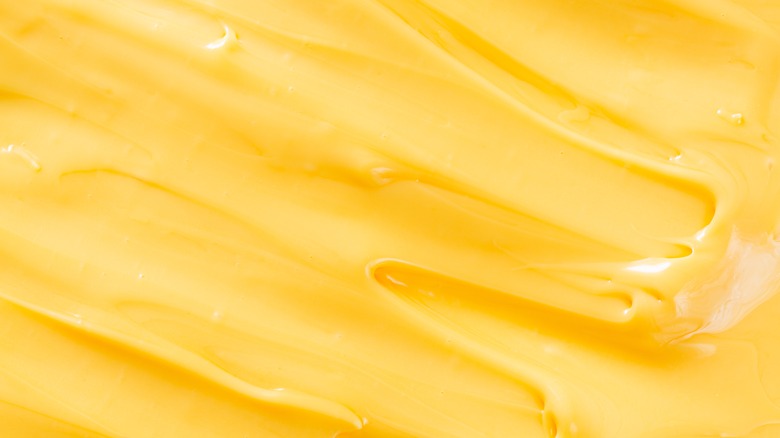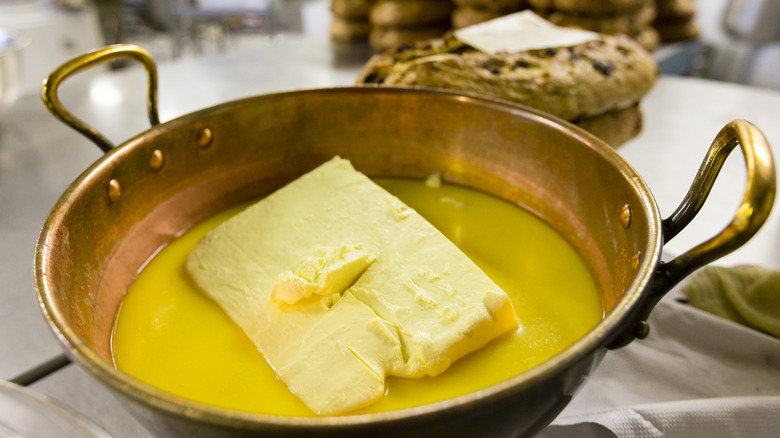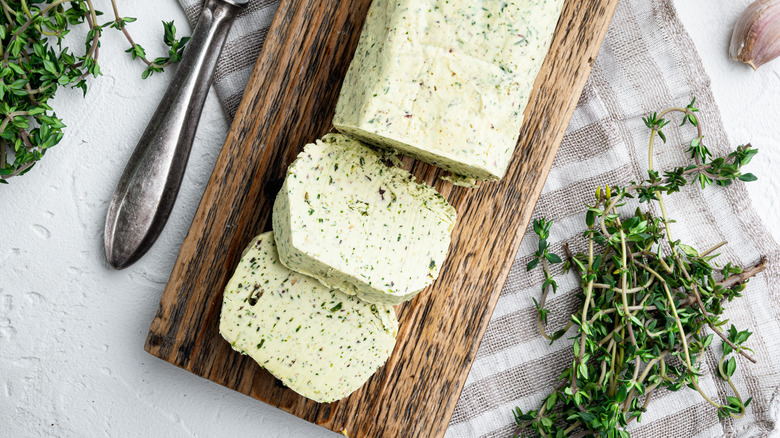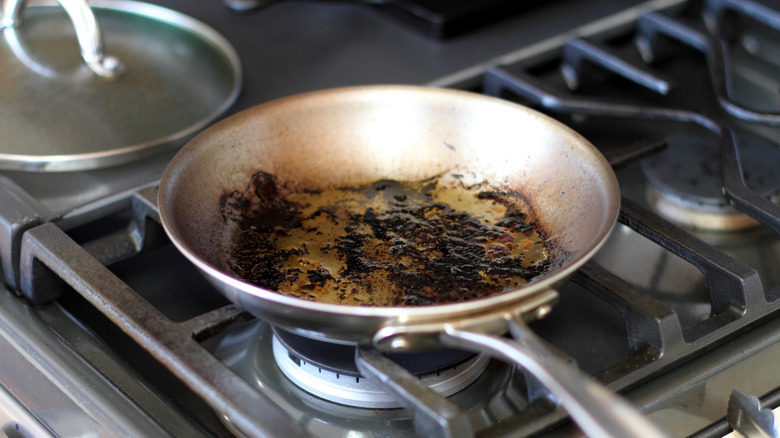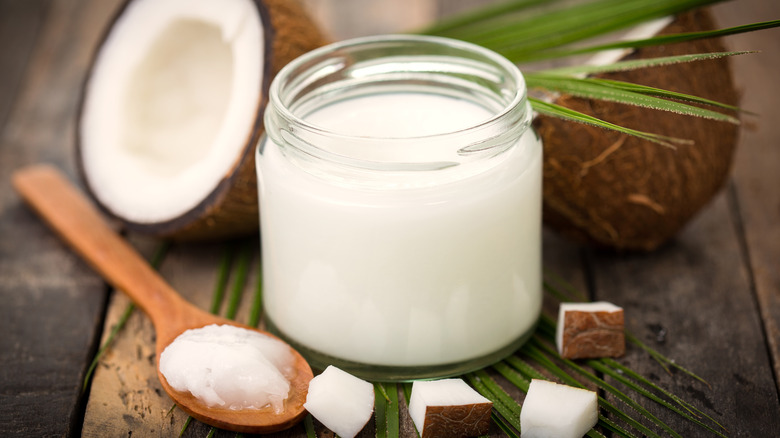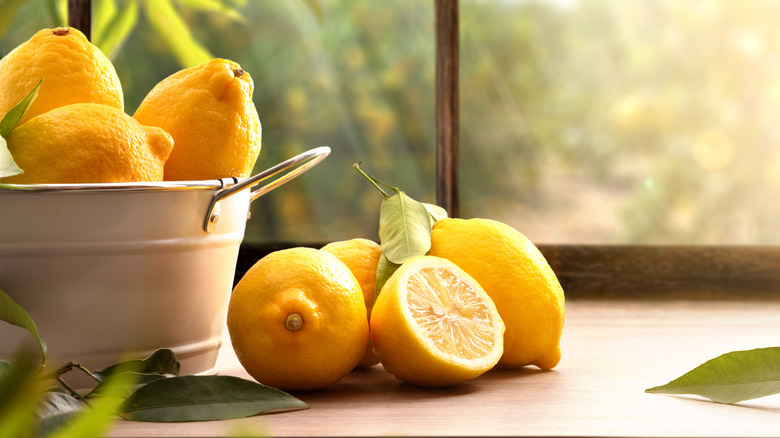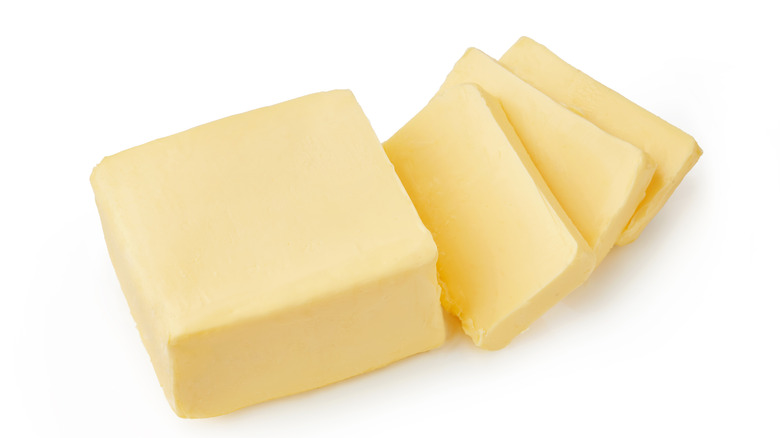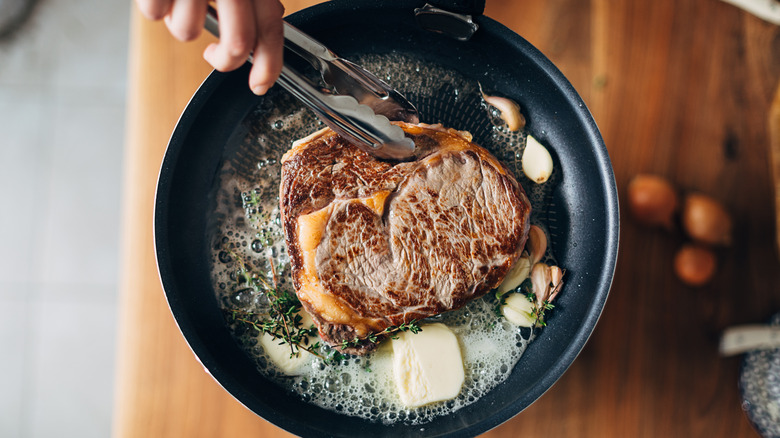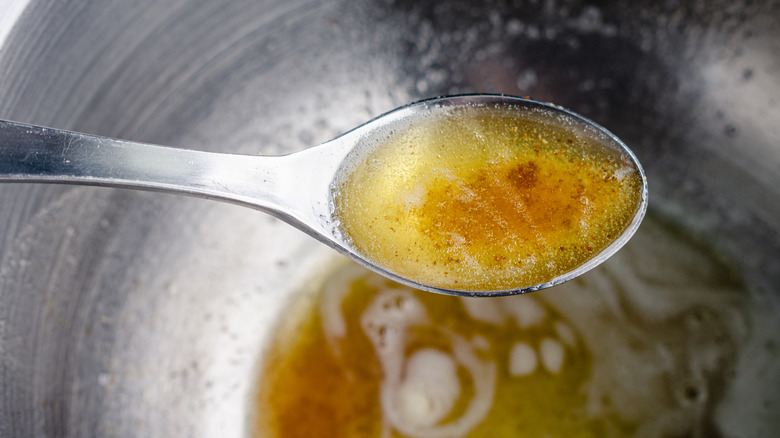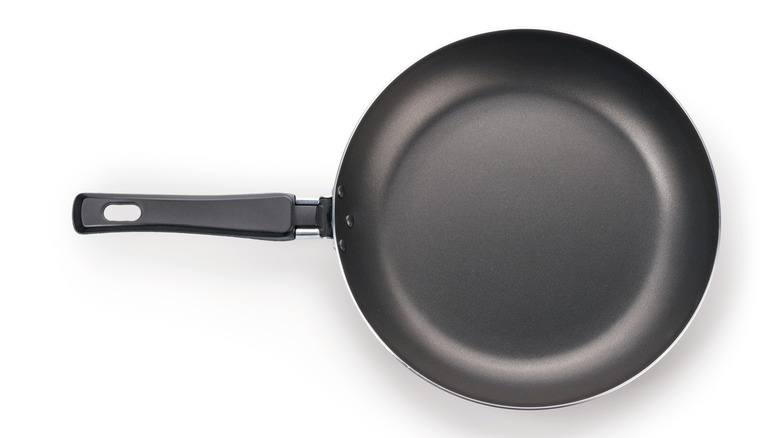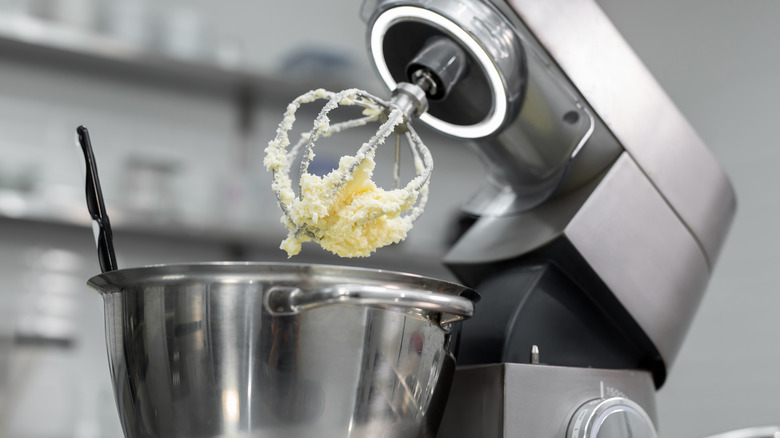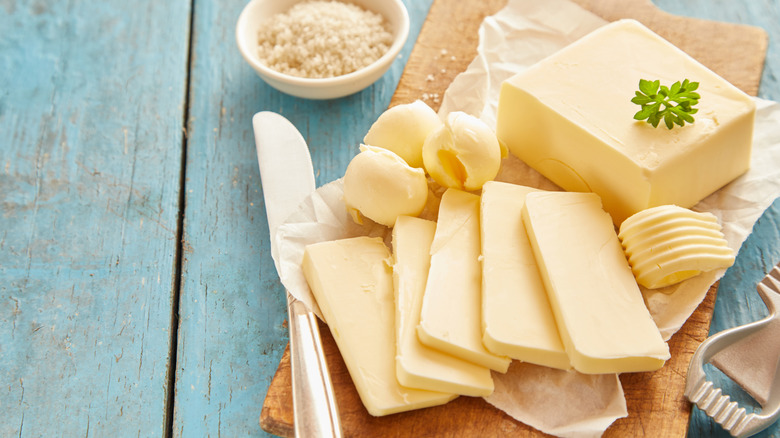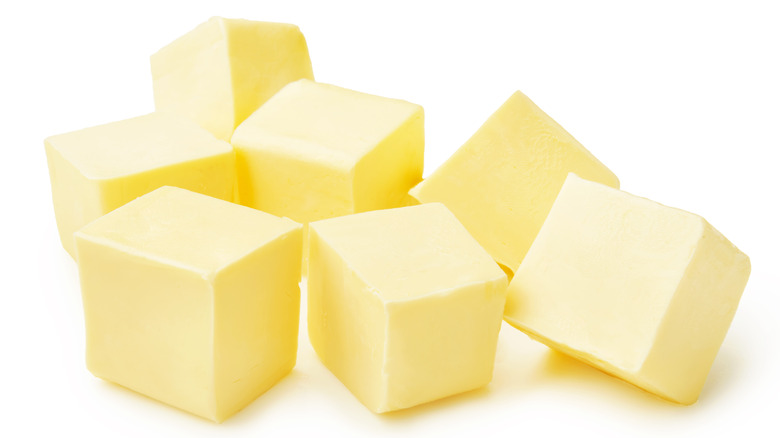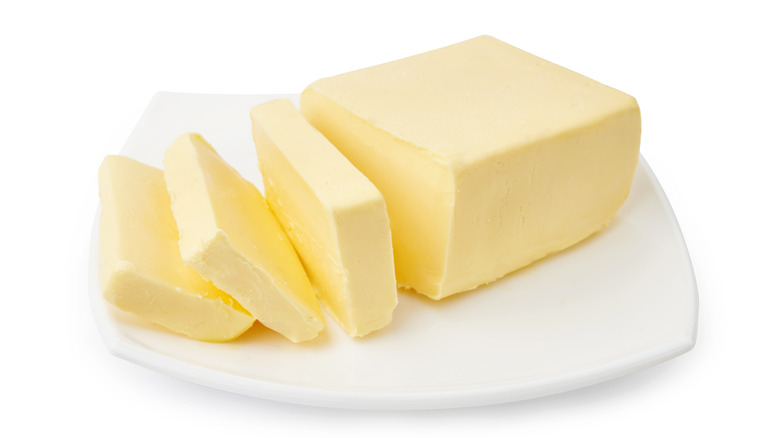12 Biggest Mistakes You're Making With Butter
Butter: It's a kitchen staple for much of the animal product-consuming world. Rich, creamy, and full of fat, it adds flavor and texture to everything it touches. Truthfully, we wouldn't want to live in a world without it. But just because you use the stuff on a regular basis doesn't mean that you never make mistakes with it. In fact, because of its versatility, butter can be a finicky ingredient to work with, as it can be used in various ways for different recipes. And unfortunately, messing up the butter-related portion of a recipe can have disastrous effects on the rest of the dish.
That's why it's so important to know what you're doing when it comes to cooking with butter. Before you turn the stove on, butter your pan, or take out your mixer so you can start creaming your butter, take a look at some of the most common mistakes people make when they're working with butter. By avoiding these mistakes, you can better ensure that you're handling your butter with the respect and the reverence it deserves — and you may just find that all of your butter-filled dishes come out even better than you could've imagined.
Using butter at the wrong temperature
One of the most common mistakes people make with butter is using it at the wrong temperature. You may not think that this makes much of a difference, but it could technically ruin some recipes. A large portion of recipes call for room temperature butter. But unfortunately, a lot of people don't even know what this means. Room temperature butter should actually be cool to the touch.
On the other hand, some baking recipes, particularly those for pie crusts, call for cold butter, which means that you'll want to use it when it's straight out of the refrigerator. Using warm butter in this situation would not yield the intended results — you'd likely end up with a sad, droopy pie. Then again, if you use that same cold butter for a recipe that calls for softened butter, you're going to run into other problems. Your best bet is to pay close attention to what the recipe calls for, and plan your butter-warming protocols properly.
Not adding other ingredients to your butter
Butter tastes amazing all on its own, so you may feel like it's not necessary to add anything to yours. But missing out on the joys of compound butter is a big mistake. Not only can these flavored butters taste amazing when they're served simply, like on a piece of bread, but you can also use them to inject more flavor into a variety of recipes.
If you're interested in creating a sweet butter, consider adding cinnamon and sugar, strawberry, or even pumpkin spice seasoning. Of course, you probably won't want to use these types of butter in a recipe for baked goods, but they taste amazing when they're smeared on top of a waffle or some French toast.
But what if you want to keep things on the savory side? In that case, you can always stick to the classics by making a garlic herb butter. Add as much garlic as you want, and then choose the herbs you love the most — we particularly like parsley and rosemary, but feel free to experiment. The best part about making flavored butter is the fact that you can customize it to your taste. And once you realize how easy it is to combine your favorite flavors with rich, creamy butter, you may just find that it's something you decide to do to the regular.
Burning your butter
When it comes to cooking just about anything, burning is common mistake, but it's an even bigger deal when it comes to butter. That's because butter has a low smoke point, meaning that you can't have butter on heat for long before it starts to burn. Therefore, you'll want to make sure you heat your butter carefully to avoid burning. One simple way to do this is to combine your butter with oil. You can use olive oil, but canola oil has an even lower smoke point — this will help prevent the butter from burning right away.
Another tactic to use, especially if you're not interested in using oil, is simply stirring your butter after you add it to the pan. Keep that butter moving, and it'll be more difficult for it to burn. If you notice smoke or realize that the butter has started to burn, remove it from the heat source right away.
Using a high-quality pan is also a good tip to remember. Higher-quality pans tend to be thicker, which means they provide more protection from burning since the butter is not in super-close contact with the heat source. You'll also want to make sure that your pan is completely flat. If it's not, the butter could pool in one area of the pan, increasing the chance of it burning.
Using the wrong substitute
Whether you follow a plant-based diet and don't want to eat butter or simply don't happen to have any in the house when you're cooking a recipe that calls for it, using a butter substitute can come in handy sometimes. Luckily, there are a ton of suitable substitutes for butter. However, you can't use them all in the same way, so it pays to know what butter does in the recipe you're making and what other ingredient could play a similar role.
For example, coconut oil can be used as a replacement for butter in many recipes, but you should keep in mind that it could slightly alter the flavor of what you're making. Therefore, if you're making a pasta sauce, you might be better off substituting olive oil for butter instead of using coconut oil. When it comes to baking, applesauce, Greek yogurt, nut butters, and even mashed bananas can play the role of butter, but just think twice about the flavors you're adding to your dish. An apple spice cake, for example, would probably taste better with an applesauce substitute than it would with mashed banana.
If you're looking for an ingredient to replace butter that you would spread over bread or baked goods, consider using olive oil, cheese, or hummus instead. Basically, you're looking for fat and creaminess.
Not balancing the butter with acid
We love butter because of its richness, its creaminess, and its intensity of flavor — that's what makes it so appealing. But just because it's amazing on its own doesn't mean it doesn't need to be balanced with other ingredients in any given recipe. That's why it's so important to know how to use acids in cooking when you're working with butter. According to The Chopping Block, acids and fats can both add flavor to a dish, but when they're used together, they complement each other and smooth out each other's more overpowering qualities. They write that with butter, like other fats, "the creaminess tends to 'mellow out' the tart mouth sensation of the acid and adds its own flavor to the dish."
So, what acids should you be using to balance out the creaminess and richness of all that butter? It depends what you're cooking and what kinds of flavors you want to work with, but lemon, lime, and vinegar (in all its iterations) are some great places to start. It can take a while to figure out how much acid you need to add to a butter-heavy dish, but once you start experimenting, you'll soon figure out what's appealing to your palate.
Over-softening your butter
We already know that keeping butter at the correct temperature is important, especially when it comes to baking. But what about when a recipe calls for "softened" butter? All too often, home cooks make the mistake of over-softening their butter. Take it too far, and you'll be left with a pool of melted butter that can leave you struggling to pull the recipe together. Melted butter and softened butter act very differently in recipes — the melted stuff is more comparable to liquid oil.
If you end up melting your butter instead of softening it, you'll want to set it aside and use it later for another purpose. Take out another stick of butter and try again. For best results, keep your butter out of the microwave and let it soften on its own. Grating or cutting your butter into small pieces will help it soften faster, or you can roll it out using a rolling pin and wax paper to prevent sticking. These methods won't result in instant softened butter, but they will prevent your butter from melting. Plan ahead so your butter is at the right temperature when you need it.
Adding butter to a searing steak too soon
We all love a grilled steak, but there's something about cooking a steak in a pan that yields such a fantastic flavor and texture. Perhaps the best part of a pan-seared steak is the addition of butter — it adds a richness to the meat that's hard not to love. But searing a steak well is a difficult skill to master for a lot of reasons, and adding butter to the dish just makes things more complicated. The biggest mistake you should be avoiding regarding steak and butter is adding the butter to the steak you're searing too early in the process. This is because, according to Kitchen Seer, if you add it too early in the cooking process, you could end up burning your butter due to its low smoke point. The last thing you want to do is ruin an expensive steak because of a bit of burnt butter.
So, exactly when should you add the butter to the pan you're searing steak in? Generally, you should be adding it when your steak is almost completely cooked. Kitchen Seer says it's a good idea to add that butter when your steak has already been removed from the heat source and is resting. Don't worry — the pan will still be hot enough to melt that butter in an instant. Spoon it over the top of the steak, and get ready to serve up your dish.
Walking away from the stove while making brown butter
Browning butter is a useful skill to have, but it can be tricky learning how to do it just right. While more general cooking with butter offers a bit of flexibility, unfortunately, browning butter does not. You need to be especially careful during this process to avoid burning the butter. That's why it's especially important not to walk away from the stove while you're browning your butter. In fact, you're going to want to keep stirring it the whole time to make sure that the butter cooks evenly.
Luckily, you're not going to have to stand there stirring forever. Browning your butter should take around five to eight minutes. You'll notice that the butter will start browning nicely, and a foam should develop. When that foam starts to dissolve, you'll know that your butter is ready to come off the heat. Just remember to pour the butter into a separate dish once you've gotten the pan off the burner — otherwise, the butter will continue to cook in the hot pan. While this process does involve some patience and close attention, it's not too difficult once you know what you're doing.
Using a dark-colored pan to brown your butter in
For most recipes, the color of your pan will have pretty much no bearing on how the finished product comes out. However, when it comes to browning butter, that's not the case. It's important to brown your butter in a light-colored pan. White is ideal, but any other very light color will do. Why does the color of the pan matter, you may ask? Basically, you just want to be able to see what you're doing. When you're working with a dark-colored pan, you won't be able to see when the color of the butter darkens. However, a lighter-colored pan will allow you to see that color change right away.
Of course, you may not have a light-colored pan at home, and if that's the case, you may want to invest in one. On the other hand, you can always try to brown butter in a darker-colored pan — just pay extra close attention to ensure the butter isn't burning.
Not spending long enough creaming butter
If you're a baker, you know that creaming butter and sugar — the process of mixing them together until the butter is fully incorporated into the fat — is an important part of many recipes, especially when it comes to developing the right texture. One of the biggest mistakes you can make with butter is not creaming it with the sugar for long enough. Generally, this will take about two to three minutes if you're using a mixer (and you should — the process is exhausting if you try to do it by hand).
So, what happens if you don't cream your butter and sugar for long enough? You're going to end up with dense cookies, cake, or cupcakes. That's probably not what you're looking for in your baked goods, so make sure that the butter looks whipped and smooth before you put your mixer away.
Mixing up salted and unsalted butter
There's one classic mistake that home cooks tend to make a lot with butter, and that's mixing up the salted and the unsalted stuff. If you're not paying attention to the recipe you're following or to the butter at the store, you may get the wrong stuff. According to MasterClass, salted butter offers more flavor than the unsalted kind, and it'll actually last longer in the fridge — that's because the salt acts as a preservative.
But that doesn't mean that salted butter belongs in every recipe. For example, if you're baking something in which the salt content really matters, you won't want to use salted butter because you just won't have enough control over the sodium content. Additionally, you probably won't want to use salted butter when you're making super-sweet dishes like cake. On the other hand, you may want to opt for salted butter when you're cooking savory dishes or when you can be a bit more lenient with the salt content. Once you've figured out whether you need the salted or the unsalted stuff, make sure you pick up the right kind at the store — it's easy to overlook the label.
Forgetting to cut butter into pieces when making brown butter
As you've probably already realized, browning butter can be a tricky process, and it's easy to mess it up. One mistake that people often make when browning butter is throwing a whole stick into the pan. You may not think that this would matter much since you're melting the whole thing anyway. But this actually isn't a smart move if you want your butter to have the best flavor possible. That's because throwing a whole stick of butter into the pan at one time means that the butter isn't going to brown evenly — the parts that are touching the pan at first will cook more, while the butter toward the center of the stick won't get as browned.
Instead, you're going to want to cut your butter into small pieces before throwing it into the pan. That way, the butter will melt and cook evenly, giving you perfectly browned butter. Yes, it requires taking an extra step, but it'll be well worth it when you add that beautifully browned butter to your recipe.
Thinking you can't leave your butter on the counter
If you've grown up like many of us, you may assume that because butter is a dairy product, it always has to go in the fridge if you're not actively using it. But, you may be surprised to find out that butter can actually hang out on the counter for quite some time — depending on the circumstances, of course. First of all, you need to find out if it's pasteurized or unpasteurized. If it's the former (which almost all butter in the U.S. is), you can feel good about storing your butter on the counter. It can hang out unrefrigerated for one to two days, according to the United States Department of Agriculture, but after that the taste might go off. Others claim it'll last on the counter for a week. This is due to butter's relatively high fat and low water contents (per Healthline). Regardless, you shouldn't feel too worried about eating the butter you accidentally left out overnight.
However, that doesn't mean all butter can be unrefrigerated for a long period of time. If you're working with unpasteurized butter, which you may be able to find at farmers markets or small farms, you will want to make sure you put it back in the refrigerator right away.
